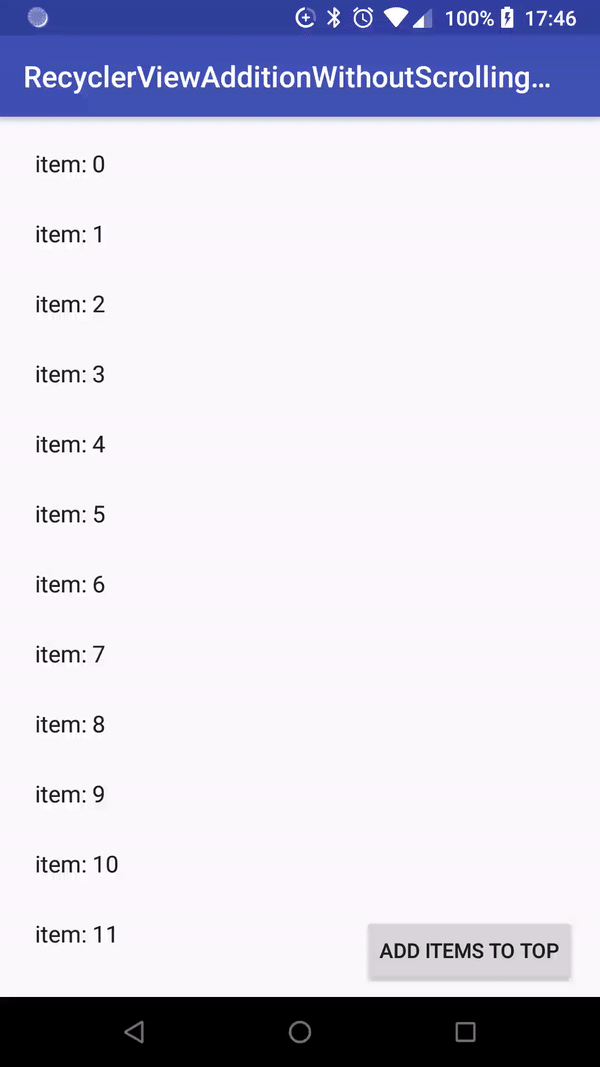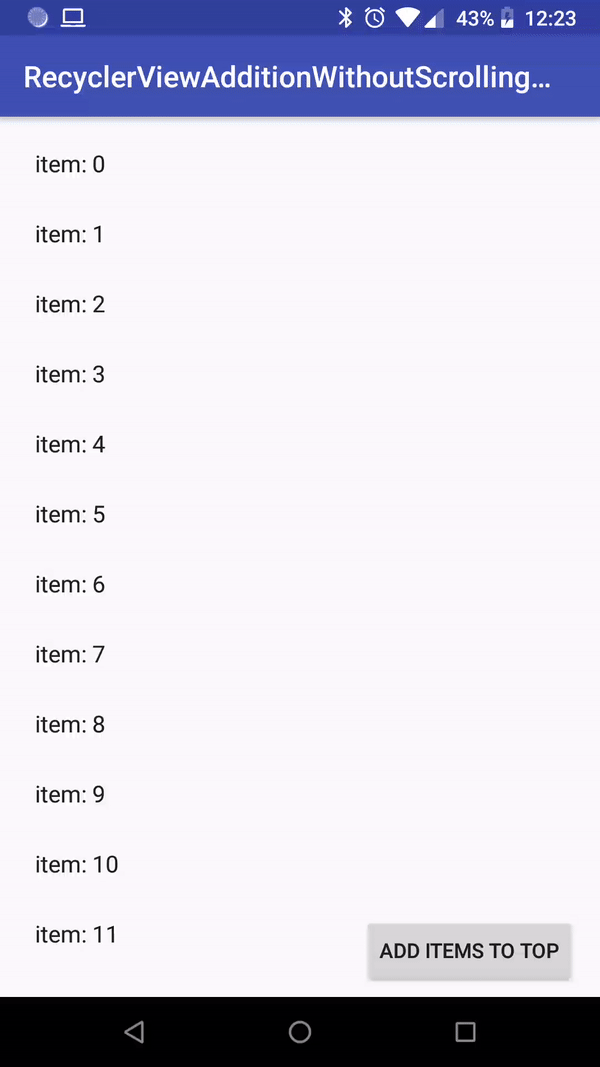In case your RecyclerView gets new items, it is best to use notifyItemRangeInserted, together with unique, stable id for each item, so that it will animate nicely, and without changing what you see too much:

As you can see, the item "0", which is the first on the list, stays on the same spot when I add more items before of it, as if nothing has changed.
This is a great solution, which will fit for other cases too, when you insert items anywhere else.
However, it doesn't fit all cases. Sometimes, all I get from outside, is : "here's a new list of items, some are new, some are the same, some have updated/removed" .
Because of this, I can't use notifyItemRangeInserted anymore, because I don't have the knowledge of how many were added.
Problem is, if I use notifyDataSetChanged, the scrolling changes, because the amount of items before the current one have changed.
This means that the items that you look at currently will be visually shifted aside:

As you can see now, when I add more items before the first one, they push it down.
I want that the currently viewable items will stay as much as they can, with priority of the one at the top ("0" in this case).
To the user, he won't notice anything above the current items, except for some possible end cases (removed current items and those after, or updated current ones in some way). It would look as if I used notifyItemRangeInserted.
I tried to save the current scroll state or position, and restore it afterward, as shown here, but none of the solutions there had fixed this.
Here's the POC project I've made to try it all:
class MainActivity : AppCompatActivity() {
val listItems = ArrayList<ListItemData>()
var idGenerator = 0L
var dataGenerator = 0
class ListItemData(val data: Int, val id: Long)
override fun onCreate(savedInstanceState: Bundle?) {
super.onCreate(savedInstanceState)
setContentView(R.layout.activity_main)
val adapter = object : RecyclerView.Adapter<RecyclerView.ViewHolder>() {
val inflater = LayoutInflater.from(this@MainActivity)
override fun onCreateViewHolder(parent: ViewGroup?, viewType: Int): RecyclerView.ViewHolder {
return object : RecyclerView.ViewHolder(inflater.inflate(android.R.layout.simple_list_item_1, parent, false)) {}
}
override fun onBindViewHolder(holder: RecyclerView.ViewHolder?, position: Int) {
val textView = holder!!.itemView as TextView
val item = listItems[position]
textView.text = "item: ${item.data}"
}
override fun getItemId(position: Int): Long = listItems[position].id
override fun getItemCount(): Int = listItems.size
}
adapter.setHasStableIds(true)
recyclerView.adapter = adapter
for (i in 1..30)
listItems.add(ListItemData(dataGenerator++, idGenerator++))
addItemsFromTopButton.setOnClickListener {
for (i in 1..5) {
listItems.add(0, ListItemData(dataGenerator++, idGenerator++))
}
//this is a good insertion, when we know how many items were added
adapter.notifyItemRangeInserted(0, 5)
//this is a bad insertion, when we don't know how many items were added
// adapter.notifyDataSetChanged()
}
}
}
<?xml version="1.0" encoding="utf-8"?>
<android.support.constraint.ConstraintLayout
xmlns:android="http://schemas.android.com/apk/res/android" xmlns:app="http://schemas.android.com/apk/res-auto"
xmlns:tools="http://schemas.android.com/tools" android:layout_width="match_parent"
android:layout_height="match_parent"
tools:context="com.example.user.recyclerviewadditionwithoutscrollingtest.MainActivity">
<Button
android:id="@+id/addItemsFromTopButton" android:layout_width="wrap_content" android:layout_height="wrap_content"
android:layout_marginBottom="8dp" android:layout_marginEnd="8dp" android:layout_marginRight="8dp"
android:text="add items to top" app:layout_constraintBottom_toBottomOf="parent"
app:layout_constraintEnd_toEndOf="@+id/recyclerView"/>
<android.support.v7.widget.RecyclerView
android:id="@+id/recyclerView" android:layout_width="0dp" android:layout_height="0dp"
android:layout_marginBottom="8dp" android:layout_marginEnd="8dp" android:layout_marginStart="8dp"
android:layout_marginTop="8dp" android:orientation="vertical"
app:layoutManager="android.support.v7.widget.LinearLayoutManager"
app:layout_constraintBottom_toBottomOf="parent" app:layout_constraintEnd_toEndOf="parent"
app:layout_constraintStart_toStartOf="parent" app:layout_constraintTop_toTopOf="parent"/>
</android.support.constraint.ConstraintLayout>
Is it possible to notify the adapter of various changes, yet let it stay on the exact same place?
Items that are viewed currently would stay if they can, or removed/updated as needed.
Of course, the items' ids will stay unique and stable, but sadly the cells size might be different from one another.
EDIT: I've found a partial solution. It works by getting which view is at the top, get its item (saved it inside the viewHolder) and tries to scroll to it. There are multiple issues with this though:

Here's the new code :
class MainActivity : AppCompatActivity() {
val listItems = ArrayList<ListItemData>()
var idGenerator = 0L
var dataGenerator = 0
class ListItemData(val data: Int, val id: Long)
override fun onCreate(savedInstanceState: Bundle?) {
super.onCreate(savedInstanceState)
setContentView(R.layout.activity_main)
val adapter = object : RecyclerView.Adapter<ViewHolder>() {
val inflater = LayoutInflater.from(this@MainActivity)
override fun onCreateViewHolder(parent: ViewGroup?, viewType: Int): ViewHolder {
return ViewHolder(inflater.inflate(android.R.layout.simple_list_item_1, parent, false))
}
override fun onBindViewHolder(holder: ViewHolder, position: Int) {
val textView = holder.itemView as TextView
val item = listItems[position]
textView.text = "item: ${item.data}"
holder.listItem = item
}
override fun getItemId(position: Int): Long = listItems[position].id
override fun getItemCount(): Int = listItems.size
}
adapter.setHasStableIds(true)
recyclerView.adapter = adapter
for (i in 1..30)
listItems.add(ListItemData(dataGenerator++, idGenerator++))
val layoutManager = recyclerView.layoutManager as LinearLayoutManager
addItemsFromTopButton.setOnClickListener {
for (i in 1..5) {
listItems.add(0, ListItemData(dataGenerator++, idGenerator++))
}
val firstVisibleItemPosition = layoutManager.findFirstVisibleItemPosition()
val holder = recyclerView.findViewHolderForAdapterPosition(firstVisibleItemPosition) as ViewHolder
adapter.notifyDataSetChanged()
val listItemToGoTo = holder.listItem
for (i in 0..listItems.size) {
val cur = listItems[i]
if (listItemToGoTo === cur) {
layoutManager.scrollToPositionWithOffset(i, 0)
break
}
}
//TODO think what to do if the item wasn't found
}
}
class ViewHolder(itemView: View) : RecyclerView.ViewHolder(itemView) {
var listItem: ListItemData? = null
}
}
Just set your LayoutManager and adapter for the first time. Make a setDataList method in your adapter class. And set your updated list to adapter list. And then every time of calling API set that list to setDataList and call adapter.
getItemCount() : RecyclerView calls this method to get the size of the data set.
When used, pass the child Class Object, and in onCreateViewHolder , use Reflection to create the child ViewHolder. When you get an onBindViewHolder, just pass it to the ViewHolder.
I would solve this problem using the DiffUtil api. DiffUtil is meant to take in a "before" and "after" list (that can be as similar or as different as you want) and will compute for you the various insertions, removals, etc that you would need to notify the adapter of.
The biggest, and nearly only, challenge in using DiffUtil is in defining your DiffUtil.Callback to use. For your proof-of-concept app, I think things will be quite easy. Please excuse the Java code; I know you posted originally in Kotlin but I'm not nearly as comfortable with Kotlin as I am with Java.
Here's a callback that I think works with your app:
private static class MyCallback extends DiffUtil.Callback {
private List<ListItemData> oldItems;
private List<ListItemData> newItems;
@Override
public int getOldListSize() {
return oldItems.size();
}
@Override
public int getNewListSize() {
return newItems.size();
}
@Override
public boolean areItemsTheSame(int oldItemPosition, int newItemPosition) {
return oldItems.get(oldItemPosition).id == newItems.get(newItemPosition).id;
}
@Override
public boolean areContentsTheSame(int oldItemPosition, int newItemPosition) {
return oldItems.get(oldItemPosition).data == newItems.get(newItemPosition).data;
}
}
And here's how you'd use it in your app (in java/kotlin pseudocode):
addItemsFromTopButton.setOnClickListener {
MyCallback callback = new MyCallback();
callback.oldItems = new ArrayList<>(listItems);
// modify listItems however you want... add, delete, shuffle, etc
callback.newItems = new ArrayList<>(listItems);
DiffUtil.calculateDiff(callback).dispatchUpdatesTo(adapter);
}
I made my own little app to test this out: each button press would add 20 items, shuffle the list, and then delete 10 items. Here's what I observed:
If you love us? You can donate to us via Paypal or buy me a coffee so we can maintain and grow! Thank you!
Donate Us With